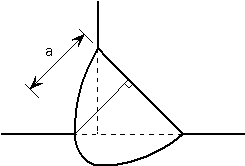Design Strength of Welded Connection
Intermittent fillet welds and intermittent partial penetration butt welds should only be used where crevice corrosion is unlikely to occur. Furthermore, continuous partial penetration butt welds should be used with care in marine or very heavily polluted onshore environments, particularly where capillary action might occur.
Guidance should always be sought regarding the correct choice of welding consumables for the grade(s) of stainless steel to be joined, and a suitable welding process employed for the type and position of joint to be welded.
Fillet welds
The angle of intersection of members connected by fillet welds should be such that the angle between the fusion faces of a weld is not less than 60 degrees and not more than 120 degrees. Outside these limits, the adequacy of the connection should be determined on the basis of tests. As for carbon steel (refer to BS 5950-1, clause 6.7.2.5), a single fillet weld should not be used in situations that produce a bending moment about the longitudinal axis of the weld if this causes tension that may open the root of the weld.
The effective length of a fillet weld may be taken as the overall length of the full-size fillet less one leg length,s, for each end which does not continue round a corner. However, a fillet weld with an effective length less than4s or less than 40 mm should not be used to carry load.
The effective throat size, a, of a fillet weld should be taken as the perpendicular distance from the root of the weld to a straight line joining the fusion faces that lies within the cross-section of the weld.

The force per unit length transmitted by a fillet weld at a given point in its length should be determined from the applied forces and moments, under ULS loading conditions (refer to BS5950:1 cl. 2.4.1.1) using the elastic section properties of the weld or weld group, based on effective throat sizes. The design stress in a fillet weld should be calculated as the force per unit length transmitted by the weld, divided by the effective throat size a.
The capacity should be taken as sufficient if, throughout the length of the weld, the vector sum of the design stresses due to all factored forces and moments transmitted by the weld does not exceed its design strengthpw.
The design strength of the weld pw, should be taken as:
pw= 0.5 Ue
but not more than the lesser of 0.46* Us and py
where:
Us is the specified minimum ultimate tensile strength of the weakest part of parent metal to be joined
Ue is the minimum tensile strength of the electrode, as specified in the relevant product standard
py is design strength, conventionally taken as the 0.2% proof strength
For austenitic stainless steel electrodes, typical values of Ue lie between 550 N/mm² and 600 N/mm², whilst for Duplex electrodes Ue will be in the region of 800N/mm², therefore the weld strength is likely to be governed by the lesser of 0.46 Us and py. Advice should be sought from the parent metal/ weld consumables supplier if in doubt about welding techniques and/or suitable consumables for the job, especially if new grades of parent metal are being used.
Properties apply to material up to 75mm thick.
*Transverse properties
As an alternative to this basic method, which conservatively assumes that all stresses are in shear, the directional method given in BS 5950-1, clause 6.8.7.3 can be used. In this method the forces per unit length transmitted by the weld are resolved into a longitudinal shear FL parallel to the axis of the weld, and a resultant transverse force FT perpendicular to this axis, thus permitting an enhancement in the transverse weld capacity of up to 25%.
Butt welds
The design strength of a full penetration butt weld may be taken as equal to the design strength of the weaker of the parts joined, provided that the weld satisfies the recommendations outlined in the introduction to this article, and that an electrode of minimum specified tensile strength at least equal to that of the parent metal is used. The throat size of a single sided, or of each side of a doubled sided partial penetration butt weld, should be taken as the minimum depth of penetration of that side of the weld, and not less than √ 2 t of the thinner part joined. For further guidance, refer to BS5950:1 cl. 6.9.
Related References:
1. Welding Process and Letter Designations
2. Welding Stainless Steel to other Steel
3. Welding and Post Fabrication Cleaning for Construction and Architectural Application
4. Welded Stainless Steel Pipe
5. Post weld cleaning and finishing of stainless steel
6. Avoid PWHT Post Weld Heat Treatment
7. Fume Associated With Welding Stainless Steel
8. Avoiding Distortion During Welding Stainless Steel
9. Design Strength of Welded Connections
10. Processes for Welding Stainless Steel
11. Brazing Stainless Steel
12. Soldering Stainless Steel
13. Welding Stainless Steel
14. Selection of Welding Consumables Filler
15. Selection of Welding Consumable for Welding Stainless Steel
16. Filler Metals For Welding Stainless Steel
17. Schaeffler and Delong Diagrams for Predicting Ferrite Levels
18. Welding Properties of Stainless Steel
|
